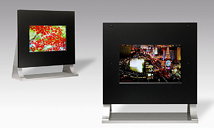Tuesday, April 10th 2007
TMD Develops the World's Largest OLED Display
Toshiba Matsushita Display (TMD) has developed the world's largest 20.8-inch low-temperature poly-silicon (LTPS) organic light-emitting diode (OLED) display panel to advance to the next-generation of flat-screen TV sets and monitors. The new 20.8-inch OLED display has been developed based on LTPS technology, which TMD has been continually refining, and an electroluminescent coating process, which is advantageous for larger display screen sizes. The three (RGB) color-emitting layers use polymer organic electroluminescent materials, and an ink-jet type coating process is adopted for coating of each color. These have contributed to achieving a large screen size of 20.8-inch and would enable the expansion of potential applications of large-size OLED panels, which have been conventionally limited to smaller size screens. The newly developed panel will be exhibited in TMD's booth at the 3rd International FPD Expo (Display 2007) at Tokyo Big Sight from April 11 through April 13, 2007.
Source:
TMD

14 Comments on TMD Develops the World's Largest OLED Display
Such a shame as it has so much potential.
SAMSUNG Develops the World’s Largest 21-inch OLED for TVs
www.samsung.com/PressCenter/PressRelease/PressRelease.asp?seq=20050104_0000089670#
www3.shopping.com/xPF-Samsung-OLED-21~r-1~CLT-INTR~RFR-www.google.com
Samsung 40-inch OLED TV Display Breakthrough
www.digitaltechnews.com/news/2005/05/samsung_40inch_.html
Sony's 1,000,000:1 contrast ratio 27-inch OLED HDTV
www.engadget.com/2007/01/08/sonys-1-000-000-1-contrast-ratio-27-inch-oled-hdtv/
But.. still ain't quite ready for prime-time yet, they've made break-throughs on the blue lifespan, but still needs improvement. And there are so many manufacturing techniques, I think their still trying to pick the best ones to run with.
Another technology that may be cheaper and easier to produce than OLED displays, are the hybrid LCD with LED backlighting. This technology offers the best of both worlds with LCD's and each pixel having it's own backlight LED, which help produce very high contrast ratios which are close to that of Plasma displays.
OLED as a viable flat panel display technology may have missed the boat.
Only time will tell when we see the goods. I'm still shopping for an LCD tv :)
Does OLED?
Also I heard that these have a short lifetime, is it true?
Keep in mind that there are 6,360 consecutive hours in a year.
And I don't know how they define "lifespan" (if it's half-life or what?)
forums.techpowerup.com/showthread.php?t=29163
This sure is pretty: Sony 1,000,000:1 Contrast 27" OLED Oh and it's 1080p!!!
OLED displays are actually just that - in essence, each pixel is a colored LED.